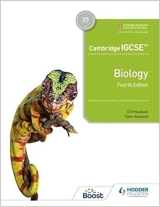Chapter 13. Breathing
Page 123
1. Nasal cavity, trachea, bronchus, alveolus.
2. The absorbing surfaces are very large; thousands of alveoli, thousands of villi.
The epithelium lining of both organs is very thin, consisting of a single-cell layer.
Both organs are richly supplied with a network of capillaries which carry off digested food or
allow rapid transport of oxygen.
Page 126
1. The diaphragm muscle contracts and so do the external intercostal muscles.
2. External intercostal muscles contract, ribs rise, thorax expands, lungs expand, air enters
lungs.
3. The alveoli would expand most. The bronchioles would expand very little.
Page 127
1.
Respiration is the production of energy from glucose. Ventilation is the process which
refreshes the air supply in the lungs. Gaseous exchange refers to the output of carbon dioxide
and intake of oxygen which takes place across the epithelium of the lungs.
Ventilation ensures a constant replenishment of oxygen in the lungs and the removal of carbon
dioxide. Gaseous exchange allows the oxygen to reach the blood vessels in the lungs and the
carbon dioxide to leave. The oxygen absorbed by gaseous exchange reaches the cells and
allows the production of energy in respiration.
2. The oxygen molecule is carried to the alveoli via the trachea, bronchus and bronchiole. It
diffuses through the alveolar lining to reach a capillary where it combines with the
haemoglobin in the red blood cell. The oxygenated blood is then carried from the lung to the
right atrium of the heart in the pulmonary vein.
3. The direction of diffusion depends on the relative concentrations of the gases on each side of
the alveolar lining. The oxygen concentration in the lungs is greater than that in the blood, so
oxygen diffuses from the alveolar air into the capillaries. Conversely, the carbon dioxide
concentration in the blood is greater than that in the alveoli. So CO2 diffuses out of the blood
into the alveoli.
4. Exhaled air still contains 16% oxygen which is quite enough to oxygenate the blood.
5. a At rest, you breathe about 16 times a minute and exchange 500cm3 with each breath. This
amounts to 16 x 500 = 80,000 cm3 (80 litres).
b Similarly, during exercise, the breathing rate can be 20 - 30 times a minute and exchange
30 + 5 litres. So you might exchange between 20 x 35 = 700 and 30 x 35 = 1050 litres.
Page 129
1. a The immediate effects on the breathing system are constriction of the bronchioles, cessation
of the ciliary movement and over-production of mucus.
b The long-term effects are ‘smokers’ cough’, breakdown of the alveolar walls (emphysema),
and chronic bronchitis.
2. The breakdown of the alveolar walls leads to a reduced surface for the absorption of oxygen.
This means the breathing rate has to increase up to the point where it no longer meets the
demands of the body for oxygen.
3. If you smoke 20 cigarettes a day, you are 13 times more likely to suffer from lung cancer than
is a non-smoker.
4. Bronchitis, emphysema, heart disease, atheroma in the leg arteries, strokes, bladder cancer,
gastric and duodenal ulcers, gum disease, tooth decay and tuberculosis.
|
Downloads
Download the answers in PDF format below
Section 1, Chapters 1-5
Section 2, Chapters 6-9
Section 3, Chapters 10-12
Section 3, Chapters 13-17
Section 3, Chapters 18-20
Section 4, Chapters 21-24
Section 5, Chapters 25-27
Section 5, Chapters 28-29
Section 6, Chapters 30-34
Section 6, Chapters 35-37
Section 7, Chapters 38-39
Section 8, Chapters 40-41
|
